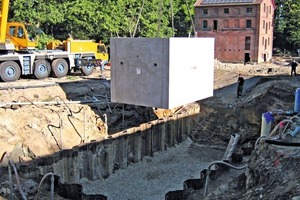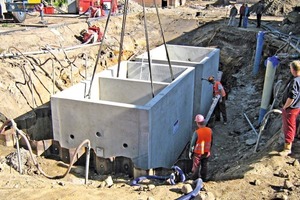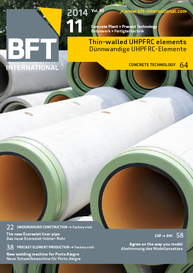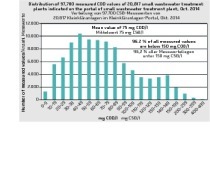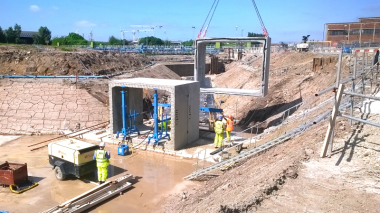Precast concrete elements for ecological
wastewater treatment
A constructed wetland system for wastewater treatment was built in the course of the rehabilitation of the Woltersburg Mill near the city of Uelzen/Germany. In order to save time and money, those responsible for the building project decided to use precast concrete elements for the construction of the sedimentation tank. The watermill and various partly historical buildings are the heart of the idyllic grounds surrounded by deciduous forest and running water in the center of the region Lune-burg Heath. They were renovated by unemployed young people in a workmanlike manner with the collaboration of local crafts and trades.
“Some hundred unemployed people were renovating on the site until the completion of the buildings,” states Gerard Minnaard, spokesman of the German association IDA “Integration durch Arbeit” (Integration through Work). “Ecological aspects were in particular taken into account here. Thus, we wanted an ecological solution for wastewater disposal and decided in favor of a constructed wetland system.”
Precast concrete elements as economic alternative
Constructed wetlands are fully biological wastewater treatment plants, in which the wastewater is mechanically routed into a settling pit first, retaining above all suspended solids and floating matters. After this preliminary purification, the wastewater flows into the sump shaft, from where it is pumped to the purification bed. Here the wastewater is seeping through a sand filter. The wastewater purified by the microorganisms contained in the soil filter is collected through drainage pipes and drained into the adjacent river Wipperau via a manhole. Apart from the field with the constructed wetland system, the wastewater treatment plant thus consists of the underground components sludge trap, primary treatment and a small pumping station.
“Initially, the sludge trap and the adjacent basins for the primary treatment were to be made of in-situ concrete. This however would have implied that costs for dewatering would have been very high owing to the long assembly time in groundwater areas,” comments Gerhard Noack, site manager of GPR Rohrleitungsbau located in Bad Bodenteich. “As the whole Woltersburg Mill project was financed with donations, it was important for us to find an economic alternative.”
The customized proposal of Berding Beton GmbH with precast concrete elements allowed us to reduce the initially scheduled installation time to three days. Hence the costs were much lower than with the previously calculated construction method. The sludge trap has a base area of 4.70 x 3.70 m and the primary treatment comprising two chambers covers an area of 5.70 x 3.50 m. As a result, the volume of the mechanic pre-purification amounts to approximately 50 m³. The monolithic precast elements weighing approximately 38 t had to be moved with the aid of a 250-t crane.
Reduced installation time and nonodorous operation
However, not only the reduced installation time was decisive for the selection of precast concrete elements: “The formation of aggressive decomposition products is also a problem in wastewater disposal,” adds site manager Noack. “Particularly low flow rates or long flow times result in a low pH value, with wastewater fouling quickly – providing a nutrient medium for the formation of badly smelling hydrogen sulphide.” If sulphur water compounds with the condensation water on the manhole walls in a chemical reaction, the so-called biogenic sulphuric acid corrosion (BSA) occurs. These aggressive acids can lead to large structural damages with far reaching consequences.
“As we could not exclude the fact that a low pH value may occur in operation of the wastewater plant, we discussed with the people of Berding about any possible countermeasure. Since the company is specialized in the field of precast concrete manholes, an appropriate solution could be found quickly.” site manager Gerhard Noack proudly states.
In this way, on the one hand, a favorable ventilation was created allowing a virtually ordorless operation of the plant. On the other hand, the basins were covered on the inside with a multilayer epoxy resin coating, which is a suitable protection against BSA owing to the low mechanical load of the surface during operation. In the meantime, the constructed wetland system has been completed and is operating perfectly.

